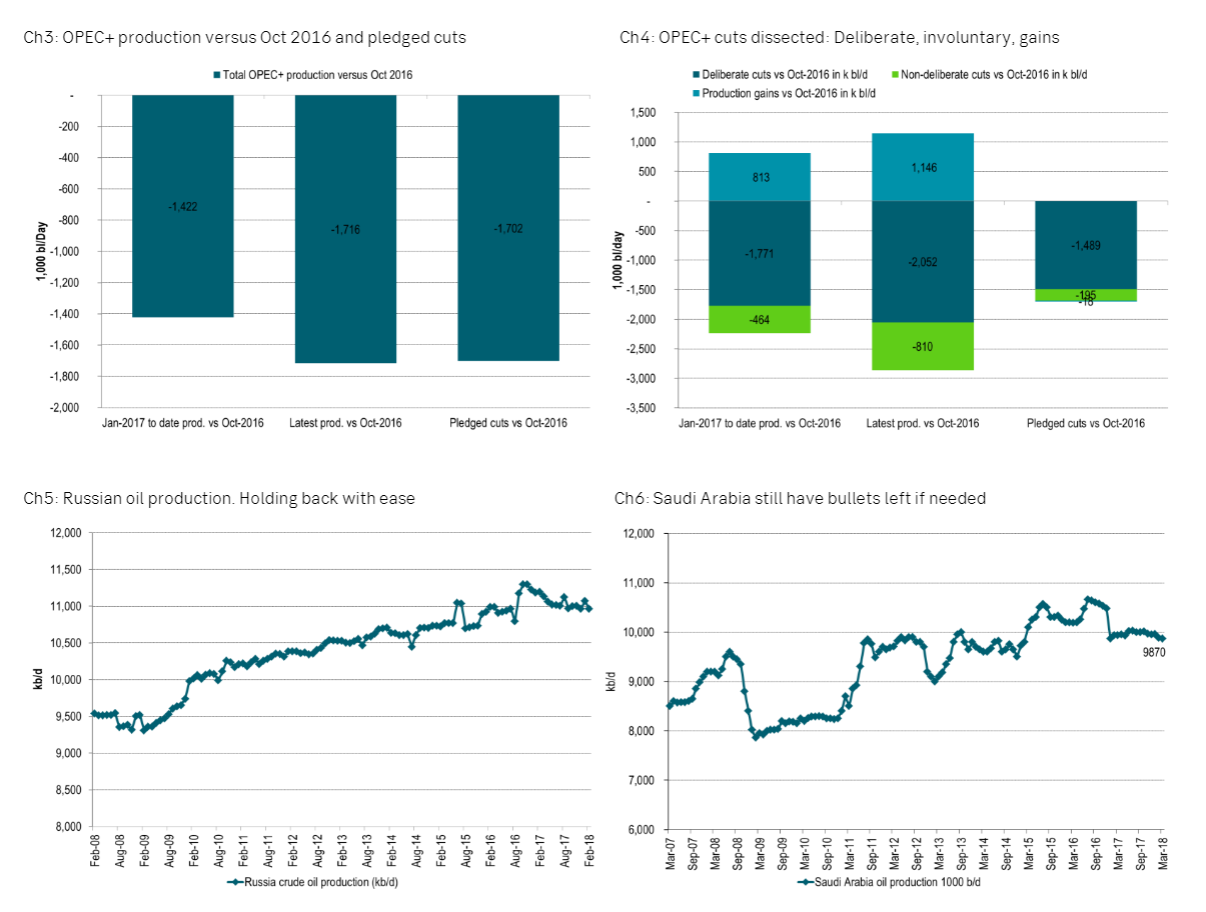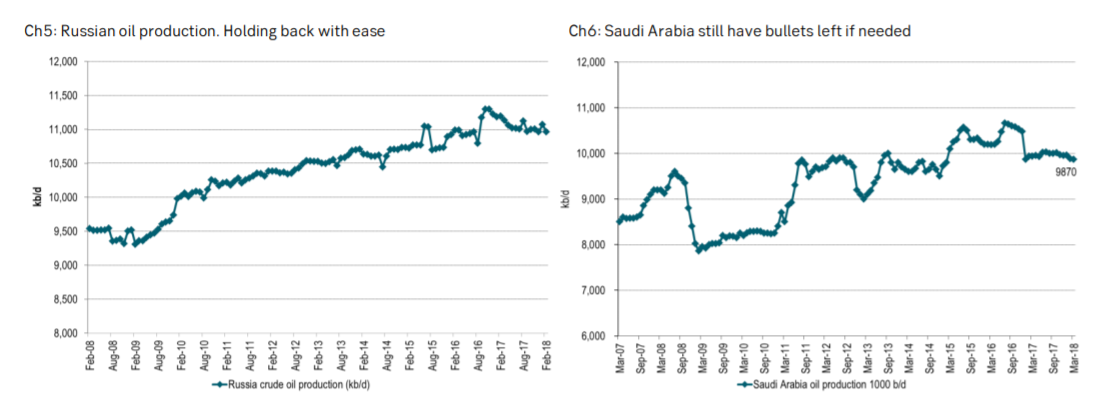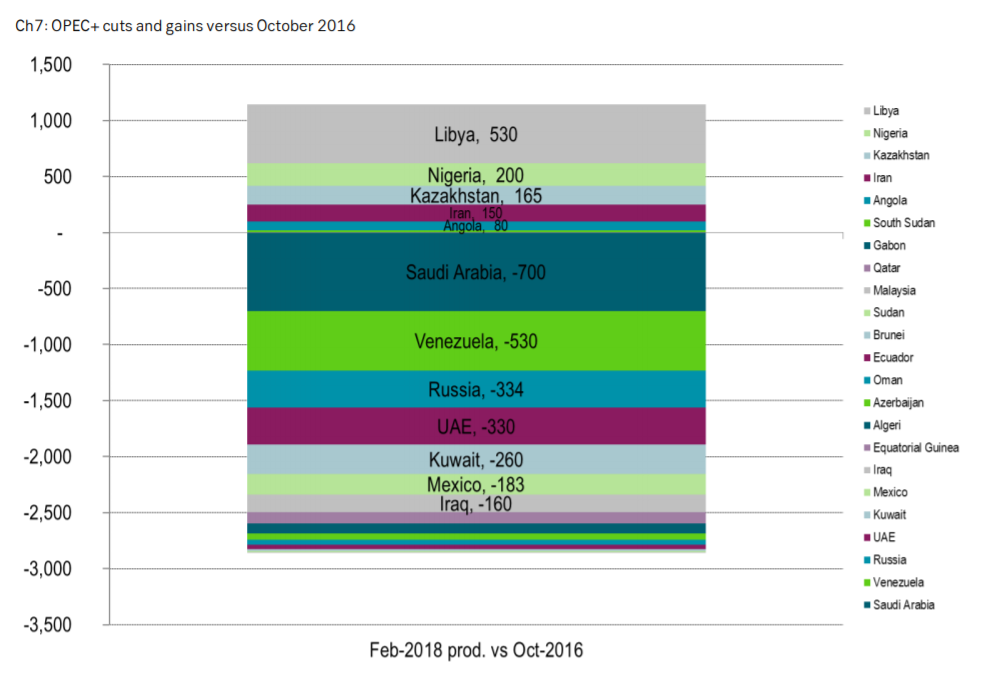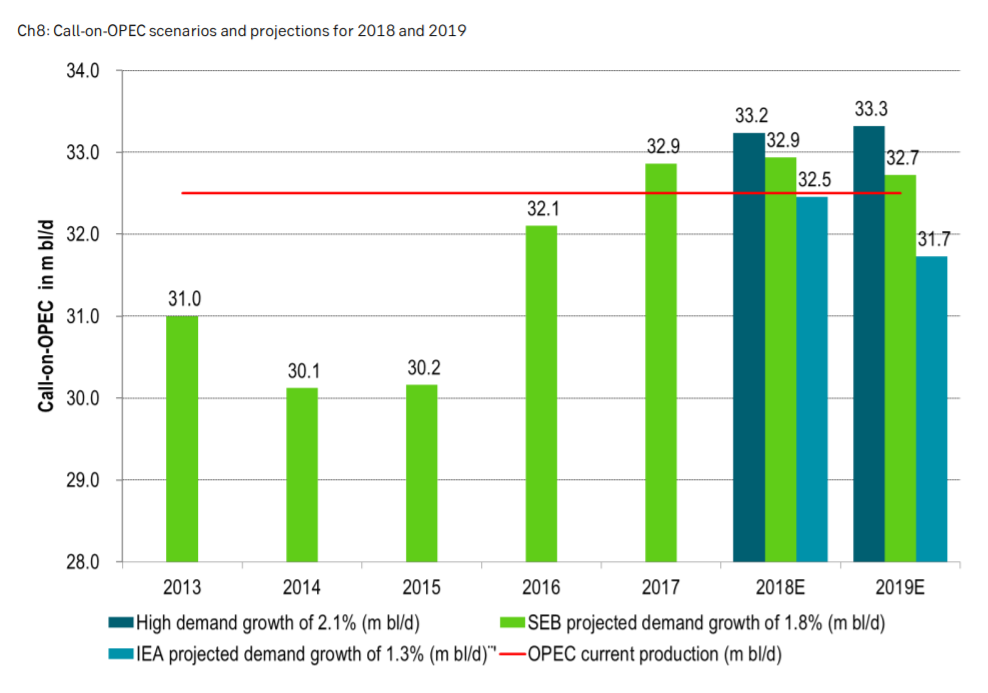Analys
Successful production cuts but exit is not so easy

 Brent crude oil is trading up 0.2% this morning to $71.5/bl supported by Kuwait’s statement that OPEC will discuss extending production cuts to 2019 at its June meeting in Vienna. Extending cuts to 2019 is not about driving inventories yet lower and the oil price yet higher. It is about avoiding inventories from rising back up again. OPEC+ has cut production, drawn down OECD inventories to just 24 million barrels above the rolling five year average in February with target in sight in May. Thus victory as such, but the group cannot place its deliberate cuts back into the market neither this year nor in 2019. The group is to a larger or lesser degree stuck with its cuts for the time being and in 2019. We estimate that deliberate cuts amounted to 2 m bl/d in February versus seasonally adjusted OECD inventory draw down of 0.2 m bl/d through Jan and Feb this year. This does not mean that US shale has OPEC+ up against the wall quite yet. Saudi Arabia for one still has plenty of ammunition left if needed. The group just cannot yet place its cuts back into the market. The main vulnerability is the OPEC+ cooperation. If that fell apart we would see rising inventories and falling oil prices. The rising tension in Syria is bullish if it leads to sanctions towards Russian oil exports but it would be bearish if it sows the seeds of division within the OPEC+ group. For now and in 2019 our view is that OPEC+ is in control of the oil market and it is not out of bullets even though it cannot exit cuts.
Brent crude oil is trading up 0.2% this morning to $71.5/bl supported by Kuwait’s statement that OPEC will discuss extending production cuts to 2019 at its June meeting in Vienna. Extending cuts to 2019 is not about driving inventories yet lower and the oil price yet higher. It is about avoiding inventories from rising back up again. OPEC+ has cut production, drawn down OECD inventories to just 24 million barrels above the rolling five year average in February with target in sight in May. Thus victory as such, but the group cannot place its deliberate cuts back into the market neither this year nor in 2019. The group is to a larger or lesser degree stuck with its cuts for the time being and in 2019. We estimate that deliberate cuts amounted to 2 m bl/d in February versus seasonally adjusted OECD inventory draw down of 0.2 m bl/d through Jan and Feb this year. This does not mean that US shale has OPEC+ up against the wall quite yet. Saudi Arabia for one still has plenty of ammunition left if needed. The group just cannot yet place its cuts back into the market. The main vulnerability is the OPEC+ cooperation. If that fell apart we would see rising inventories and falling oil prices. The rising tension in Syria is bullish if it leads to sanctions towards Russian oil exports but it would be bearish if it sows the seeds of division within the OPEC+ group. For now and in 2019 our view is that OPEC+ is in control of the oil market and it is not out of bullets even though it cannot exit cuts.
Brent crude oil is trading slightly lower morning at $71.3/bl after having been supported by Kuwait’s statement that OPEC will discuss extending production cuts to 2019 at its June meeting in Vienna. It is clear that the production cuts by OPEC+ has been successful in terms of drawing down global oil inventories and lifting prices in consequence. On average OECD inventories drew down about 0.75 m bl/d during the last 7 months of 2017 while they have only been drawing down 0.2 m bl/d through Jan and Feb this year. Both adjusted for seasonal trends. OPEC+ has delivered hard on its pledged cuts but with significant internal variations with respect to deliberate cuts, involuntary cuts and production increases. In comparison to the OECD drawdowns mentioned above the average deliberate cuts from Jan-2017 to Feb-2018 was 1.77 m bl/d and in February the deliberate cuts were 2.1 m bl/d (not counting individual gains and involuntary cuts). What is clear is that deliberate production cuts have been much larger than the draw downs in OECD inventories. So if it had not been for the cuts by OPEC+ then the global oil market would clearly still be subdued with a significant running surplus through 2017 and very, very high inventories today.
What OPEC+ would like would of course be to cut production, draw down inventories and then put production cuts back into the market. OECD commercial inventories in February only stood 24 million barrels above the 2013 to 2017 five year average. So victory as such.
However, OPEC+ is not in a position to place its deliberate production cuts back into the market. The group is for the time being more or less stuck with its cuts. It cannot get out. At least not yet and this is why the group needs to discuss extending production cuts to 2019 at its Vienna meeting in June 20/21/22. If it wants to avoid inventories from rising back up again in 2019 it will need to maintain cuts.
But OPEC does not have its back up against the wall yet. It still has more bullets left. Just look at Saudi Arabia. Yes, it has cut production by 0.7 m bl/d versus its October 2016 production of 10.6 m bl/d. But that means that it is still producing 9.9 m bl/d at the moment. In comparison its average production from 2005 to 2016 was 9.3 m bl/d with a low of 7.86 m bl/d at the start of the crisis year 2009. In other words it can easily deepen cuts if needed even though it is not obvious if it would do so alone without cooperating cuts by the rest of OPEC+. Thus vulnerability is along the lines of further OPEC+ cooperation and cohesion.
As long as the internal cooperation within OPEC and the wider OPEC+ is not falling apart the group still has the capacity and ability to hold the oil market, to hold the oil price both this year and next year. Total OPEC+ production in Feb-2018 stood at 49.5 m bl/d plus NGL thus accounting for more than 50% of global supply. OPEC+ is not home free to place its cuts back into the market again neither now or in 2019. Extending cuts to 2019 is not about driving inventories yet lower and the oil price yet higher. It is about avoiding inventories from rising back up again. If Venezuela declines more than expected or if US sanctions are revived towards Iran it may allow some return of deliberate cuts.
Analys
Tightening fundamentals – bullish inventories from DOE

The latest weekly report from the US DOE showed a substantial drawdown across key petroleum categories, adding more upside potential to the fundamental picture.

Commercial crude inventories (excl. SPR) fell by 5.8 million barrels, bringing total inventories down to 415.1 million barrels. Now sitting 11% below the five-year seasonal norm and placed in the lowest 2015-2022 range (see picture below).
Product inventories also tightened further last week. Gasoline inventories declined by 2.1 million barrels, with reductions seen in both finished gasoline and blending components. Current gasoline levels are about 3% below the five-year average for this time of year.
Among products, the most notable move came in diesel, where inventories dropped by almost 4.1 million barrels, deepening the deficit to around 20% below seasonal norms – continuing to underscore the persistent supply tightness in diesel markets.
The only area of inventory growth was in propane/propylene, which posted a significant 5.1-million-barrel build and now stands 9% above the five-year average.
Total commercial petroleum inventories (crude plus refined products) declined by 4.2 million barrels on the week, reinforcing the overall tightening of US crude and products.


Analys
Bombs to ”ceasefire” in hours – Brent below $70

A classic case of “buy the rumor, sell the news” played out in oil markets, as Brent crude has dropped sharply – down nearly USD 10 per barrel since yesterday evening – following Iran’s retaliatory strike on a U.S. air base in Qatar. The immediate reaction was: “That was it?” The strike followed a carefully calibrated, non-escalatory playbook, avoiding direct threats to energy infrastructure or disruption of shipping through the Strait of Hormuz – thus calming worst-case fears.

After Monday morning’s sharp spike to USD 81.4 per barrel, triggered by the U.S. bombing of Iranian nuclear facilities, oil prices drifted sideways in anticipation of a potential Iranian response. That response came with advance warning and caused limited physical damage. Early this morning, both the U.S. President and Iranian state media announced a ceasefire, effectively placing a lid on the immediate conflict risk – at least for now.
As a result, Brent crude has now fallen by a total of USD 12 from Monday’s peak, currently trading around USD 69 per barrel.
Looking beyond geopolitics, the market will now shift its focus to the upcoming OPEC+ meeting in early July. Saudi Arabia’s decision to increase output earlier this year – despite falling prices – has drawn renewed attention considering recent developments. Some suggest this was a response to U.S. pressure to offset potential Iranian supply losses.
However, consensus is that the move was driven more by internal OPEC+ dynamics. After years of curbing production to support prices, Riyadh had grown frustrated with quota-busting by several members (notably Kazakhstan). With Saudi Arabia cutting up to 2 million barrels per day – roughly 2% of global supply – returns were diminishing, and the risk of losing market share was rising. The production increase is widely seen as an effort to reassert leadership and restore discipline within the group.
That said, the FT recently stated that, the Saudis remain wary of past missteps. In 2018, Riyadh ramped up output at Trump’s request ahead of Iran sanctions, only to see prices collapse when the U.S. granted broad waivers – triggering oversupply. Officials have reportedly made it clear they don’t intend to repeat that mistake.
The recent visit by President Trump to Saudi Arabia, which included agreements on AI, defense, and nuclear cooperation, suggests a broader strategic alignment. This has fueled speculation about a quiet “pump-for-politics” deal behind recent production moves.
Looking ahead, oil prices have now retraced the entire rally sparked by the June 13 Israel–Iran escalation. This retreat provides more political and policy space for both the U.S. and Saudi Arabia. Specifically, it makes it easier for Riyadh to scale back its three recent production hikes of 411,000 barrels each, potentially returning to more moderate increases of 137,000 barrels for August and September.
In short: with no major loss of Iranian supply to the market, OPEC+ – led by Saudi Arabia – no longer needs to compensate for a disruption that hasn’t materialized, especially not to please the U.S. at the cost of its own market strategy. As the Saudis themselves have signaled, they are unlikely to repeat previous mistakes.
Conclusion: With Brent now in the high USD 60s, buying oil looks fundamentally justified. The geopolitical premium has deflated, but tensions between Israel and Iran remain unresolved – and the risk of missteps and renewed escalation still lingers. In fact, even this morning, reports have emerged of renewed missile fire despite the declared “truce.” The path forward may be calmer – but it is far from stable.
Analys
A muted price reaction. Market looks relaxed, but it is still on edge waiting for what Iran will do

Brent crossed the 80-line this morning but quickly fell back assigning limited probability for Iran choosing to close the Strait of Hormuz. Brent traded in a range of USD 70.56 – 79.04/b last week as the market fluctuated between ”Iran wants a deal” and ”US is about to attack Iran”. At the end of the week though, Donald Trump managed to convince markets (and probably also Iran) that he would make a decision within two weeks. I.e. no imminent attack. Previously when when he has talked about ”making a decision within two weeks” he has often ended up doing nothing in the end. The oil market relaxed as a result and the week ended at USD 77.01/b which is just USD 6/b above the year to date average of USD 71/b.

Brent jumped to USD 81.4/b this morning, the highest since mid-January, but then quickly fell back to a current price of USD 78.2/b which is only up 1.5% versus the close on Friday. As such the market is pricing a fairly low probability that Iran will actually close the Strait of Hormuz. Probably because it will hurt Iranian oil exports as well as the global oil market.
It was however all smoke and mirrors. Deception. The US attacked Iran on Saturday. The attack involved 125 warplanes, submarines and surface warships and 14 bunker buster bombs were dropped on Iranian nuclear sites including Fordow, Natanz and Isfahan. In response the Iranian Parliament voted in support of closing the Strait of Hormuz where some 17 mb of crude and products is transported to the global market every day plus significant volumes of LNG. This is however merely an advise to the Supreme leader Ayatollah Ali Khamenei and the Supreme National Security Council which sits with the final and actual decision.
No supply of oil is lost yet. It is about the risk of Iran closing the Strait of Hormuz or not. So far not a single drop of oil supply has been lost to the global market. The price at the moment is all about the assessed risk of loss of supply. Will Iran choose to choke of the Strait of Hormuz or not? That is the big question. It would be painful for US consumers, for Donald Trump’s voter base, for the global economy but also for Iran and its population which relies on oil exports and income from selling oil out of that Strait as well. As such it is not a no-brainer choice for Iran to close the Strait for oil exports. And looking at the il price this morning it is clear that the oil market doesn’t assign a very high probability of it happening. It is however probably well within the capability of Iran to close the Strait off with rockets, mines, air-drones and possibly sea-drones. Just look at how Ukraine has been able to control and damage the Russian Black Sea fleet.
What to do about the highly enriched uranium which has gone missing? While the US and Israel can celebrate their destruction of Iranian nuclear facilities they are also scratching their heads over what to do with the lost Iranian nuclear material. Iran had 408 kg of highly enriched uranium (IAEA). Almost weapons grade. Enough for some 10 nuclear warheads. It seems to have been transported out of Fordow before the attack this weekend.
The market is still on edge. USD 80-something/b seems sensible while we wait. The oil market reaction to this weekend’s events is very muted so far. The market is still on edge awaiting what Iran will do. Because Iran will do something. But what and when? An oil price of 80-something seems like a sensible level until something do happen.
-

 Nyheter3 veckor sedan
Nyheter3 veckor sedanStor uppsida i Lappland Guldprospekterings aktie enligt analys
-

 Nyheter4 veckor sedan
Nyheter4 veckor sedanBrookfield ska bygga ett AI-datacenter på hela 750 MW i Strängnäs
-

 Nyheter4 veckor sedan
Nyheter4 veckor sedanSommaren inleds med sol och varierande elpriser
-

 Nyheter3 veckor sedan
Nyheter3 veckor sedanSilverpriset släpar efter guldets utveckling, har mer uppsida
-

 Analys4 veckor sedan
Analys4 veckor sedanBrent needs to fall to USD 58/b to make cheating unprofitable for Kazakhstan
-

 Nyheter4 veckor sedan
Nyheter4 veckor sedanTradingfirman XTX Markets bygger datacenter i finska Kajana för 1 miljard euro
-

 Nyheter2 veckor sedan
Nyheter2 veckor sedanUppgången i oljepriset planade ut under helgen
-

 Nyheter2 veckor sedan
Nyheter2 veckor sedanLåga elpriser i sommar – men mellersta Sverige får en ökning














